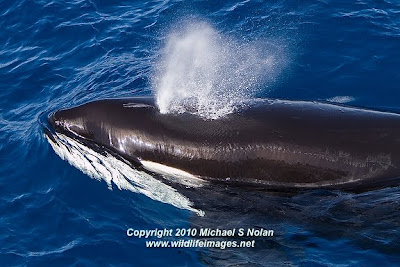April, 2010
 You want whales
You want whales and
dolphins to
photograph?
You want calm water and
amazing backdrops?
Then there is
simply no place like
the Baja Peninsula in Mexico.
This Bryde's
whale is
sub-surface
feeding off the west side
of Carmen Island
in the Gulf
of California.
Notice that his
eye is watching
while he stretches open his
gigantic mouth to scoop
up euphausids from the sea.
He keeps circling around the National Geographic Sea Bird with mouth open, what a great look at the baleen plates hanging from the upper jaw!

How about this blue whale in the lower Sea of Cortez? This is the largest animal to ever live on our planet!

These are long-beaked common dolphins, although I would submit to you that there is nothing common about them...they should be called long-beaked SPECTACULAR dolphins!

When the water is so clear and calm you can actually watch the dolphins blow break into bubbles and streak down its back.

A group of these spectacular dolphins riding the bow of the National Geographic Sea Bird.

Perhaps the friendliest large whale in the world, this California gray whale calf is posing for National Geographic photographer Ralph Lee Hopkins.

The curiosity of these young gray whale calves allows for wonderful photographic opportunities, but begs the question of just who is watching whom?

At times these animals actually seek out human contact, rubbing their rostrums on the Zodiac or lifting their heads to be scratched.

And of course what is an excited young whale to do with all of that bottled up energy? BREACH!

Humpback whales also love the Baja, this adult male is breaching off the west side of Isla Magdalena on the Pacific side of the Baja Peninsula.

A group of killer whales makes an appearance in the Pacific Ocean as well, this male is tail-lobbing, slapping the water repeatedly to mark its position to the rest of the pod.

What a thrill to see and photograph killer whales is such clear water and great sea conditions.

This mother has a calf with a most unusual dorsal fin. It looks as if it has been chopped off, but has healed completely. It will be very easy to recognize this youngster in the future!

This adult botttlenose dolphin actually has a broken lower jaw on the left side. The tip of the mandible is sticking out at a 90 degree angle to the jaw line. It seems to have healed just fine, and apparently the animal is still able to feed like normal.

Power and grace summed up in a leaping bottlenose dolphin.

Eye to eye with a curious bottlenose dolphin surfacing just off the side of the ship.
To see more of my photography please visit my website at www.wildlifeimages.net
 Seems I can't help myself. I have now literally photographed thousands of breaching whales all over the world, but still I am drawn to the power and grace of an animal of this size leaping clear of the surface of the ocean.
Seems I can't help myself. I have now literally photographed thousands of breaching whales all over the world, but still I am drawn to the power and grace of an animal of this size leaping clear of the surface of the ocean. Capturing that exact millisecond with a camera is still as exciting for me as it was the first time I did it, so many years ago...
Capturing that exact millisecond with a camera is still as exciting for me as it was the first time I did it, so many years ago... When the humpback whale breaching is only a few days old (like this newborn calf - note the gray coloration) it is that much better...
When the humpback whale breaching is only a few days old (like this newborn calf - note the gray coloration) it is that much better... Here a slightly older calf is perfecting its style!
Here a slightly older calf is perfecting its style! Sometimes it just seems like adult whales are showing off (and of course they are). Even though this adult male is breaching for the benefit of other whales in the immediate area, we humans often see the effort as being for our own personal enjoyment.
Sometimes it just seems like adult whales are showing off (and of course they are). Even though this adult male is breaching for the benefit of other whales in the immediate area, we humans often see the effort as being for our own personal enjoyment. But of course these are wild animals going about their daily lives not for our benefit, but to pass on their own genes to future generations.
But of course these are wild animals going about their daily lives not for our benefit, but to pass on their own genes to future generations. Not to say that it doesn't absolutely get your heart pumping when it happens so close to the ship you are watching from.
Not to say that it doesn't absolutely get your heart pumping when it happens so close to the ship you are watching from. 










































